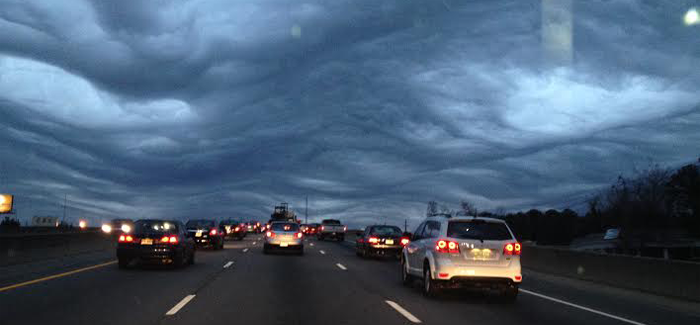
This type of wave cloud is called “undulatus asperatus.” (Photography by Scott Tufts)
Weather Channel expert Greg Forbes, SM’73, PhD’78, offers some answers in light of an, um, exciting winter.
The first time my car got stuck in the snow this winter, I learned my lesson. I stocked the car with kitty litter and a car scraper to better prepare for the next time. The second time my car got stuck in the snow this winter, I learned my second lesson, which is that kitty litter is only good for one thing and that I didn’t need a scraper, I needed a big shovel (all of which were sold out when I attempted to buy one the first time). Who can I blame for this winter? I’m not sure there is such a person. But in the meantime, who can answer some of my polar vortex-related questions? Greg Forbes, SM’73, PhD’78, severe weather expert at the Weather Channel (profiled in the Magazine in 2008), that’s who.
[[{"type":"media","view_mode":"media_original","fid":"1246","attributes":{"alt":"","class":"media-image","height":"280","typeof":"foaf:Image","width":"460"}}]]
(Photo courtesy Greg Forbes, SM’73, PhD’78)
It feels like nearly every single part of the country has been affected by extreme weather this season—if it’s not snow in the Midwest or South it’s a dearth of it in the Pacific Northwest or Alaska. Which, if any, parts of the country managed to have a fairly decent winter this year?
For the 90 days ending about February 22, the mean temperature was near average in parts of Washington, Montana, Wyoming, eastern Colorado, eastern New Mexico, western Texas, and along the Atlantic Coast.
It was warm in the Southwest and cold in parts of the Northern Plains and Great Lakes states. Ninety-day precipitation was well below average in the Southwest and parts of the south-central United States (especially east Texas and Louisiana), above average in parts of Alabama and Georgia, the Appalachians, and the Northeast.
Parts of the Northern Plains, Great Lakes, and interior Northeast have had precipitation pretty close to normal overall. When you combine the two, probably parts of Montana, east Colorado, and Wyoming had a pretty typical winter.
What other parts of the world outside the United States, that you know of, have suffered from bad weather this 2013-14?
Three of the worst weather disasters of 2013 outside of the United States were, in no particular order, (1) Typhoon Haiyan that devastated the Philippines; (2) Typhoon Phailin that hit India; (3) Hurricanes Manuel and Ingrid that hit Mexico. England suffered some of its worst flooding in decades in February 2014.
How and/or when would it be feasible to know whether this was just a tough winter or whether it was indeed caused by climate change?
While it was very cold in much of the United States in January, it was actually a warm month for the globe as a whole. Even the Northern Hemisphere as a whole was above average. It is next to impossible to prove whether or not or to what extent an individual weather event was related to climate change.
What’s a weather phenomenon the average person might not care that much about that you find fascinating?
Wave clouds are very interesting, revealing up and down motions—usually in a stable layer of the atmosphere. This is the newest type of cloud named/classified and depicts rather dramatic up and down motions within the cloud that is riding over and within a stable layer aloft (inversion) that can act like a spring and be oscillated up and down.
Unless you’re in an aircraft getting bumped around by turbulence related to them, they are probably not as interesting to the average person. But sometimes standing waves—lenticular clouds—over the crests of mountains can resemble flying saucers and capture the public’s fascination.
Do meteorologists secretly love this particular winter because it’s been so dramatic? Is mild weather bad for business?
Meteorologists tend to love active weather because it’s active and exciting to predict, cover on air, and experience. For weather companies, active weather is good for ratings and business.
What do you keep in your car in terms of bad weather preparation?
I keep a blanket, a tossle cap, gloves, and a snow/ice scraper in my car. People may want to have additional supplies in places that more frequently get winter weather. The following are recommended:
- a shovel
- windshield scraper and small broom
- flashlight
- battery powered radio
- extra batteries
- water
- snack food
- matches
- extra hats, socks, and mittens
- first aid kit with pocket knife
- necessary medications
- blanket(s)
- tow chain or rope
- road salt and sand
- booster cables
- emergency flares
- fluorescent distress flag
